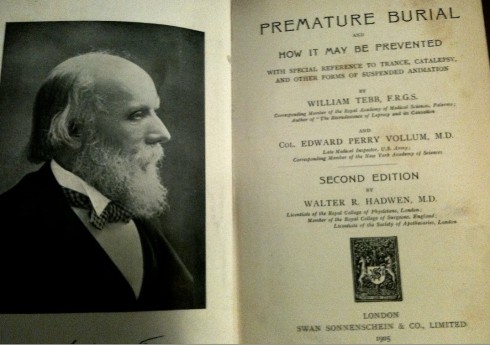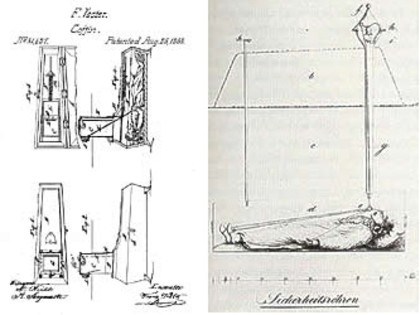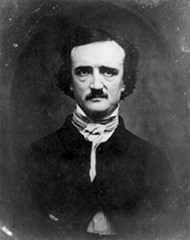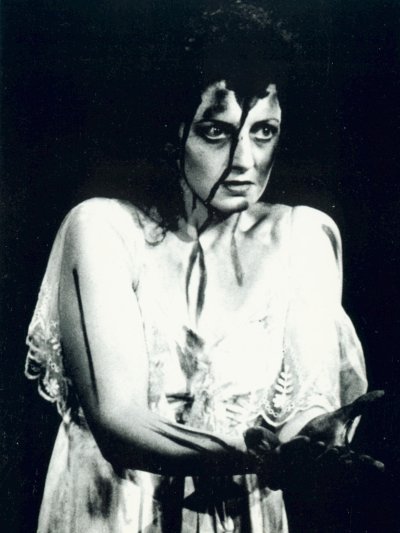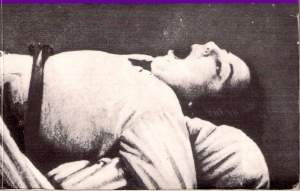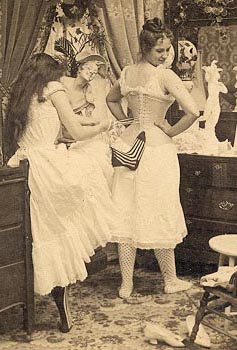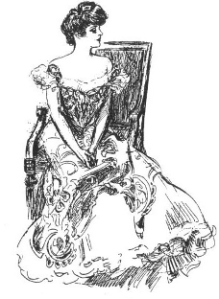 The nineteenth century female experience was one of domestic confinement in which the fathers of Victorian paterfamilias exerted sovereignty over their wives and daughters. As ‘[t]he ideal woman was willing to be dependent on men and submissive to them’[1] praise was awarded to those who ‘subordinated themselves totally to the wishes of the master of the household’[2]. Women were therefore encouraged to act in accordance with these conventions of femininity through a process of positive reinforcement to which obedience was fundamental. In this manner the symbolic patriarchal family organised and constrained the female chora, validating only certain forms of expression. Such constraint limited the range of possible, non-symbolic articulation: as Ilza Veith notes, ‘the hysterical symptoms “were modified by the prevailing concept of the feminine ideal”’ [3]. Thus:
The nineteenth century female experience was one of domestic confinement in which the fathers of Victorian paterfamilias exerted sovereignty over their wives and daughters. As ‘[t]he ideal woman was willing to be dependent on men and submissive to them’[1] praise was awarded to those who ‘subordinated themselves totally to the wishes of the master of the household’[2]. Women were therefore encouraged to act in accordance with these conventions of femininity through a process of positive reinforcement to which obedience was fundamental. In this manner the symbolic patriarchal family organised and constrained the female chora, validating only certain forms of expression. Such constraint limited the range of possible, non-symbolic articulation: as Ilza Veith notes, ‘the hysterical symptoms “were modified by the prevailing concept of the feminine ideal”’ [3]. Thus:
in the nineteenth century women were expected to be delicate and vulnerable both physically and emotionally, and this construction of femininity was reflected in the disposition to hysteria[4].
Accordingly, there was a similarity between contemporary ideological notions of the female and that of the hysteric which required extensive policing through medicalisation. Since hysteria was such an amorphous concept, and so closely linked to contemporary ideologies of femininity, the difference between the two became a matter of patriarchal judgement, resting upon the opinion of the physician. For the hegemonic order this ensured that society remained monolithic since ‘social conformity…became an index of sanity’[5] and it was through non-conformity that insanity was adjudged. Thus, via medicalisation and enforced submission patriarchy was able to coerce and govern the forms of socially-sanctioned expression that were available to women. However, through an exploration of the hysteric and the female vampire it will be demonstrated how such certainties of control betray an underlying anxiety concerning the fragility of masculine binaries.
While the Victorian ideology for women of a high socio-economic status was one of domestic felicity, contemporary literature contrastingly depicts the nightmarish lives of house-bound women in which hysteria is a constant spectre. In Charlotte Brontë’s Villette, Lucy Snowe endures mental suffocation during her service to Miss Marchmont, an elderly woman confined by rheumatism to ‘[t]wo hot, close rooms’[6]. Within such stifling residence Lucy states that ‘[a]ll within [her] became narrowed to [her] lot.’[7] Similarly, Lucy flees the Pensionnat de Demoiselles in order to relieve her claustrophobia that is manifested in the house-roof pressing upon her, as ‘crushing as the slab of a tomb’[8]. Likewise, when Emily Brontë’s Catherine Earnshaw is confined by illness to Thrushcross Grange, she suffers from such an intense feeling of captivity that she begs Nelly to ‘“[o]pen the window again wide”’[9] in a desperate attempt to escape onto the vast space of the moor.
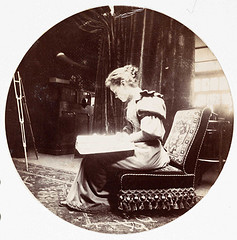 When confined indoors women had little contact with the language of masculine society and were consequently denied the intersubjectivity of social interaction. Even within the home itself women were refused vicarious access to patriarchal discourse, exemplified through Jane Eyre who is forbidden to read her cousin’s books. John Reed warns ‘“I’ll teach you to rummage the book-shelves: for they are mine”’[10] before making Jane the target of his possessive anger when he throws a volume across the drawing room. John thereby demonstrates that he is part of a masculine order that sanctions his exclusive ownership and use of such literature. Rather than engaging Jane in reasoned discussion, John instead uses physical violence and the infliction of pain in order to convey his ownership: ‘the volume was flung, it hit me’[11]. Likewise, Emily Brontë signifies how patriarchal discourse restrains and denies the feminised semiotic in Wuthering Heights. When confronted with Catherine Earnshaw’s ghost Mr Lockwood prevents her from entering the shattered window pane by ‘pil[ing] the books up in a pyramid against it’[12], creating a wall of masculine, symbolic language through which the female chora cannot penetrate.
When confined indoors women had little contact with the language of masculine society and were consequently denied the intersubjectivity of social interaction. Even within the home itself women were refused vicarious access to patriarchal discourse, exemplified through Jane Eyre who is forbidden to read her cousin’s books. John Reed warns ‘“I’ll teach you to rummage the book-shelves: for they are mine”’[10] before making Jane the target of his possessive anger when he throws a volume across the drawing room. John thereby demonstrates that he is part of a masculine order that sanctions his exclusive ownership and use of such literature. Rather than engaging Jane in reasoned discussion, John instead uses physical violence and the infliction of pain in order to convey his ownership: ‘the volume was flung, it hit me’[11]. Likewise, Emily Brontë signifies how patriarchal discourse restrains and denies the feminised semiotic in Wuthering Heights. When confronted with Catherine Earnshaw’s ghost Mr Lockwood prevents her from entering the shattered window pane by ‘pil[ing] the books up in a pyramid against it’[12], creating a wall of masculine, symbolic language through which the female chora cannot penetrate.
This exclusion of women from linguistic discourse during the Victorian era ‘brought the nervous body and its protean complaints into being’[13] exemplified in the increasing female propensity to hysterical expression. As Elisabeth Bronfen notes, such proclivity is owing to the fact that ‘hysteria exists only insofar as it results from a given network of medical, supernatural, religious, and aesthetic discourses’[14]. However, the corollary is also true – just as the condition is shaped by medical discourse, so too is the nature of that discourse shaped by its Other – the hysterical woman who resists classification. With the growing prominence and canonisation of medical opinion during the nineteenth century, the physician’s increasing preoccupation with, and diagnosis of, hysteria was due to the threat that the condition posed to medical intelligibility. This in turn challenged the masculine, empiricist rationality which underpinned scientific certainty used to justify the entire patriarchal order. Since the hysteric ‘suffered from the lack of a public voice to articulate their economic and sexual oppression’[15], their symptoms ‘seemed like bodily metaphors for [their] silence’[16]. Hysterical women therefore posed a permanent challenge to the epistemological foundation of the Victorian medical project and the values of the society that it reflected.
Through this non-verbal, bodily protest the hysteric’s challenge to medical and epistemological certainties created a dissonance within masculine hegemony whose effect seemed far louder than any linguistic complaint: as Hélène Cixous writes, ‘“[t]he great hysterics have the last speech, they are aphoric”’[17]. While Luce Irigaray states that masculine language excludes the feminine by positing woman as ‘both the subject and the Other…of a closed phallogocentric signifying economy that achieves its totalising goal through the exclusion of the feminine’[18], language cannot exclude that which is not spoken. It is therefore precisely through being designated Other that the hysteric gains power. By utilising a form of communication that is beyond the masculine definition of language their form of expression cannot be excluded.
However, while patriarchy is unable to prevent such a form of communication, the challenge that it poses to the prevailing order serves as a justification for masculine control. As Cixous writes, ‘the hysteric “makes-believe” the father, plays the father, “makes-believe” the master[19] in the sense that she occupies the role of the Other which they strive to control. Therefore, women in general, and the hysteric in particular, construct masculine society in positing themselves as the negative image, the terrifying, nebulous chaos against which patriarchy is self-defined: ‘without the hysteric there’s no father…without the hysteric, no master, no analyst, no analysis!’[20]
This self-definition is achieved through the utilisation of a patriarchal language which also functions as a means of controlling the female Other within a closed masculine signifying economy. [21] Inherent in forms of communication is the automatic positing of subject and object: if self and Other are absent, the entire universe becomes a single undifferentiated entity. It is owing to the distinction between self and Other that communication becomes necessary. For Kristeva, the awareness of such a separation is termed the ‘thetic phase’[22], occurring at the mirror stage during which the subject acknowledges their distinction from surrounding objects and their desire to communicate with the separate object world. However, within such a form of communication one party is active in its ability to posit, while the other remains passive and classifiable. Therefore, control of communication is vital to the masculine order as power lies in the ability to resist categorisation and to position the female as Other. Since the subject becomes an active agent with the ability to place the Other participant within the submissive, signified position, patriarchy is able to maintain its hegemony by controlling language and ensuring that it remains the subject with the authority to posit and resist being posited.
However, in a parody of Kristeva’s mirror phase, the characters of nineteenth century literature frequently fail to recognise their own reflection, thereby rejecting the mirror phase of thetic communication and circumventing masculine control of language. When gazing in the looking-glass in the red-room at Gateshead Jane Eyre speaks of a ‘strange little figure there gazing at me’[23] and on her wedding day at Thornfield sees ‘a robed and veiled figure, so unlike [her] usual self that it seemed almost the image of a stranger.’[24] Charlotte Brontë herself described her own nervousness ‘as a “horrid phantom”’[25], akin to the reflected ghost that Jane says ‘has the effect of a real spirit’[26], and to the ‘“face”’ [27] that Catherine Earnshaw perceives in the black press at Thrushcross Grange. These phantom reflections are the characters’ Other, part of, yet unrecognisable to, the subject.
to recognise their own reflection, thereby rejecting the mirror phase of thetic communication and circumventing masculine control of language. When gazing in the looking-glass in the red-room at Gateshead Jane Eyre speaks of a ‘strange little figure there gazing at me’[23] and on her wedding day at Thornfield sees ‘a robed and veiled figure, so unlike [her] usual self that it seemed almost the image of a stranger.’[24] Charlotte Brontë herself described her own nervousness ‘as a “horrid phantom”’[25], akin to the reflected ghost that Jane says ‘has the effect of a real spirit’[26], and to the ‘“face”’ [27] that Catherine Earnshaw perceives in the black press at Thrushcross Grange. These phantom reflections are the characters’ Other, part of, yet unrecognisable to, the subject.
For characters unable to recognise their own reflection, expression cannot be thetic according to Kristevean theory as self and Other cannot be delimited without the mirror stage. Accordingly, in creating an idiosyncratic language the hysteric becomes both subject and object, producing and receiving her own communication. Consequently, the hysteric’s entire discourse becomes self-contained, directed towards her seemingly alien mirror image which functions as her Other. Hysterical language therefore becomes infinitely reflective, causing the abyss and hollow realm of Lucy’s ‘hollow-eyed vision’[28] and Jane’s vision in the red-room mirror whose depths are involuntarily explored by her ‘fascinated glance’ [29].
Since Kristeva theorised that the symbolic ‘is a social effect of the relation to the other’[30], hysterical discourse transcends social order due to its pre-symbolic nature. The hysterical woman is therefore independent and does not require an Other in order to define her identity. Yet this poses a problem as a language that is reflected back upon the subject is only intelligible to the self. Consequently, hysterical discourse cannot be a form of universal communication, instead creating a prison within which the female subject becomes confined.
This relationship between hysteria and mirror image is also explored through the figure of the female vampire who, casting no reflection, has no Other either in masculine society or through her own likeness. Therefore, when Jane Eyre sees Bertha’s ‘“visage and features quite distinctly in the dark oblong glass”’ her face is described as ‘“fearful and ghastly”’[31], reminding Jane ‘“[o]f the foul German spectre – the Vampyre”’[32], a creature who casts no reflection, merely staring into a void, unable to ‘Other’ herself. The vampire’s absence of reflection therefore destabilised patriarchal binaries as for characters such as Lucy Westenra there is neither self nor Other, masculine nor feminine, and consequently both hysterical and symbolic communication are impossible.
Therefore, patriarchy attempted to prevent female transgression through the medium of masculine language and the maintenance of linguistic control, central to which was the enshrining of medical opinion and the authority of the physician. However, through physical expression and a rejection of the thetic phase fundamental to masculine symbolic language the hysteric was able to destabilise the subject/object binary and the medical opinion by which it was supported. This challenged Victorian ideological conceptions of feminine passivity that complimented masculine assertiveness, thereby reflecting the certainty of patriarchal power back upon the masculine subject. Such fear of the ‘unfeminine’ woman reaches its apotheosis in the figure of the female vampire who, rather than mirroring the masculine gaze, denies the masculine subject the possibility of seeing a reflection of his own power and effect through the female Other. In doing so, the hysteric, and in particular the female vampire, emphasises ‘[t]he radical dependency of the masculine subject on the female “Other”’ and thereby ‘exposes his autonomy as illusory.’[33] In casting no reflection, the vampire draws attention to the irrelevance of the gaze, not only by challenging masculine authority but also showing its absence.
Copyright © 2011 Victoria Fairclough
[1] D. Gorham, The Victorian Girl and the Feminine Ideal, (London: Croom Helm, 1982), p.4
[2] A.S. Wohl, ed., The Victorian Family, Structures and Stresses (London: Croom Helm, 1978), p.63
[3] I. Veith, Hysteria: The History of a Disease (Chicago: University of Chicago Press, 1965), p.209 in, E. Bronfen, The Knotted Subject: Hysteria and its Discontents (New Jersey: Princeton University Press, 1998), p.225
[5] S. Shuttleworth, Charlotte Brontë and Victorian Psychology (Cambridge: Cambridge University Press, 1996), p.35
[6] C. Brontë, Villette (London: Penguin Books, 2004), chapter 4
[9] E. Brontë, Wuthering Heights (London: Penguin Books, 1995), chapter 12
[10] C. Brontë, Jane Eyre (London: Penguin Books, 1996), I, chapter 1
[12] Brontë, Wuthering Heights, I, chapter 3
[13] P.M. Logan, Nerves and Narratives: A Cultural History of Hysteria in Nineteenth-Century British Prose (Califonia: University of California Press, 1997), p.2
[14] Bronfen, The Knotted Subject, p.102
[15] E. Showalter, Hystories: Hysterical Epidemics and Modern Culture (London, Picador, 1997), p.55
[17] ‘Castration or Deception?’ in, Signs 7 (1981), pp.36-55 in, P.M. Logan, Nerves and Narratives: A Cultural History of Hysteria in Nineteenth-Century British Prose (Califonia; University of California Press, 1997), p.9
[18] J. Butler, Gender Trouble: Feminism and the Subversion of Identity (London: Routledge, 1999), p.14
[19] Bronfen, The Knotted Subject, preface
[21] Butler, Gender Trouble, p.14
[22] J. Kristeva, ‘Revolution in Poetic Language’, in T. Moi, ed., The Kristeva Reader: Julia Kristeva (New York: Columbia University Press, 1986), p.98
[23] Brontë, Jane Eyre, I, chapter 2
[24] ibid, II, chapter 11
[25] T.J. Wise and J.A. Symington, The Bronte’s: Their Lives, Friendships and Correspondence, 4 vols (Oxford: Basil Blackwell, 1933), III, p.8 to Ellen Nussey, 14th July 1849 in, S. Shuttleworth, Charlotte Brontë and Victorian Psychology (Cambridge: Cambridge University Press, 1996), p.31
[26] Brontë, Jane Eyre, I, chapter 2
[27] Brontë, Wuthering Heights, I, chapter 12
[28] Brontë, Villette, chapter 4
[29] Brontë, Jane Eyre, I, chapter 2
[30] Kristeva, ‘Revolution in Poetic Language’, pp.96-7
[31] Brontë, Jane Eyre, I, chapter 25
[32] Brontë, Jane Eyre, I, chapter 25
[33] Butler, Gender Trouble, pp.xxvii-xxviii
Tags: hysteria, Kristeva, language, Victorian, women

